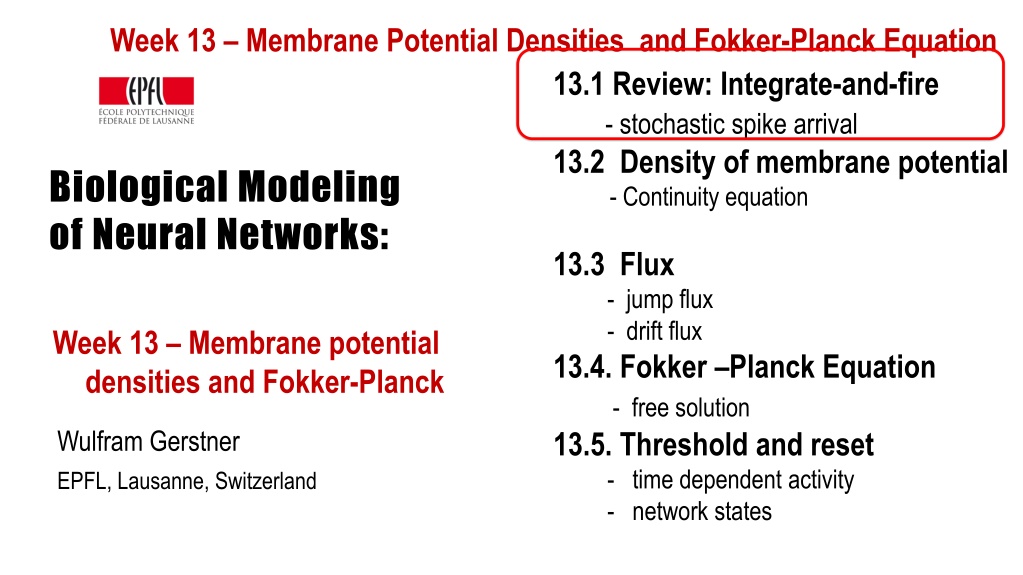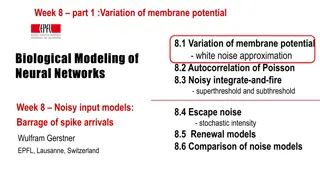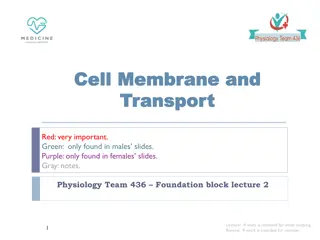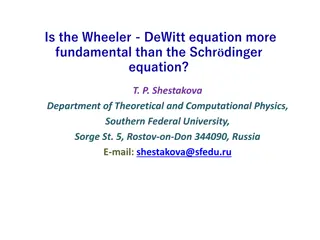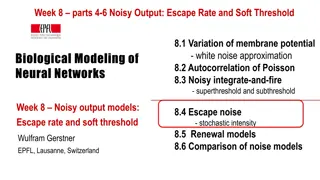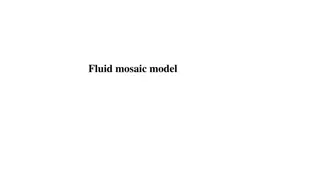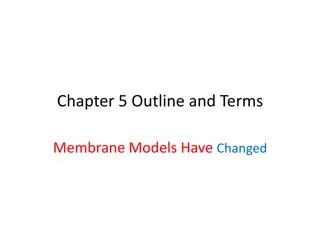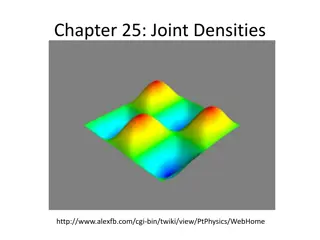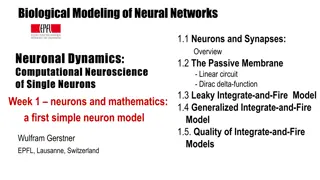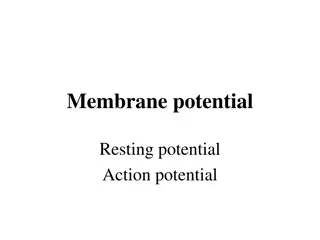Exploring Membrane Potential Densities and the Fokker-Planck Equation in Neural Networks
Delve into the concepts of membrane potential densities and the Fokker-Planck Equation in neural networks, covering topics such as integrate-and-fire with stochastic spike arrival, continuity equation for membrane potential density, jump and drift flux, and the intriguing Fokker-Planck Equation.
- Neural Networks
- Membrane Potential
- Fokker-Planck Equation
- Stochastic Spike Arrival
- Continuity Equation
Download Presentation

Please find below an Image/Link to download the presentation.
The content on the website is provided AS IS for your information and personal use only. It may not be sold, licensed, or shared on other websites without obtaining consent from the author. Download presentation by click this link. If you encounter any issues during the download, it is possible that the publisher has removed the file from their server.
E N D
Presentation Transcript
Week 13 Membrane Potential Densities and Fokker-Planck Equation 13.1 Review: Integrate-and-fire - stochastic spike arrival 13.2 Density of membrane potential - Continuity equation 13.3 Flux - jump flux - drift flux 13.4. Fokker Planck Equation - free solution 13.5. Threshold and reset - time dependent activity - network states Biological Modeling of Neural Networks: Week 13 Membrane potential densities and Fokker-Planck Wulfram Gerstner EPFL, Lausanne, Switzerland
Week 13-part 1: Review: integrate-and-fire-type models Spike emission j i iu Spike reception -spikes are events -threshold -spike/reset/refractoriness
Week 13-part 1: Review: leaky integrate-and-fire model j i iu I d u u = eq+ If firing: ( ) ( ) u u u RI t reset dt d = + = ( ); ( ) V V RI t V u u eq dt
Week 13-part 1: Review: leaky integrate-and-fire model d LIF = eq + ( ) ( ) u u u RI t dt u u If firing: reset I=0 I>0 d d u u dt dt flow (drift) towards threshold u repetitive u u resting t t
Week 13-part 1: Review: microscopic vs. macroscopic (t ) An I(t)
Week 13-part 1: Review: homogeneous population t ? I(t) Homogeneous network: -each neuron receives input from k neurons in network -each neuron receives the same (mean) external input t + ( ; ) n t t t population activity = ( ) A t N t
Week 13-part 1: Review: diffusive noise/stochastic spike arrival Stochastic spike arrival: excitation, total rate Re inhibition, total rate Ri Synaptic current pulses ) ( f k d k ' f f = + ( ) ( ) u u u R q t t q t t eq e i ' k k dt , , ' ' f EPSC + IPSC ) t d mean = + ( ) ( ) ( u u u R I t eq dt u Langevin equation, Ornstein Uhlenbeck process 0u
Week 13 part 2 Membrane Potential Densities 13.1 Review: Integrate-and-fire - stochastic spike arrival 13.2 Density of membrane potential - 13.3 Flux - - 13.4. Fokker Planck Equation - - 13.5. Threshold and reset - Biological Modeling of Neural Networks: Week 13 Membrane potential densities and Fokker-Planck Wulfram Gerstner EPFL, Lausanne, Switzerland
Week 13-part 2: membrane potential density Blackboard: density of potentials? For any arbitrary neuron in the population f k dt d k ' f f = + ( ( ) ( )) u u R q t t q t t e i ' k k , , ' ' f EPSC u IPSC + q C d dt k f = + f ext ( ) ( ) t e u t t I k , external current input excitatory input spikes
Week 13-part 2: continuity equation d dt d du = ( , ) p u t ( , ) J u t
Exercise 1: flux caused by stochastic spike arrival Membrane potential density Next lecture: 10h15 u u p(u) Reference level u0 du dt a) Jump at time t = u u + f ( ) ( )} R q t t eq e f What is the flux across u0? b) c) spike arrival rate spike arrival rate k k
Week 13 Membrane Potential Densities and Fokker-Planck Equation 13.1 Review: Integrate-and-fire - stochastic spike arrival 13.2 Density of membrane potential - continuity equation - 13.3 Flux - jump flux - drift flux 13.4. Fokker Planck Equation - 13.5. Threshold and reset - Biological Modeling of Neural Networks: Week 13 Membrane potential densities and Fokker-Planck Wulfram Gerstner EPFL, Lausanne, Switzerland
du dt flux two possibilities = u u + + ( ) ext t f ( ) ( )} R I q t t eq e f Membrane potential density What is the flux across u0? u u p(u) Reference level u0 Jumps caused at a) flux caused by jumps due to stochastic spike arrival spike arrival rate Blackboard: Slope and density of potentials b) flux caused by systematic drift
Week 13 Membrane Potential Densities and Fokker-Planck Equation 13.1 Review: Integrate-and-fire - stochastic spike arrival 13.2 Density of membrane potential - 13.3 Flux - continuity equation 13.4. Fokker Planck Equation - source and sink - 13.5. Threshold and reset - Biological Modeling of Neural Networks: Week 13 Membrane potential densities and Fokker-Planck Wulfram Gerstner EPFL, Lausanne, Switzerland
Week 13-part 4: from continuity equation to Fokker-Planck Blackboard: Derive Fokker-Planck equation For any arbitrary neuron in the population q d u u dt C 1 C q C ', ' k f = + + ' f f ext ( ) ( ) ( ) t e i t t t t I ' k k , k f EPSC external input IPSC Continuity equation: Flux: - jump (spike arrival) - drift (slope of trajectory) = ( , ) p u t ( , ) J u t t u
Week 13-part 4: Fokker-Planck equation Membrane potential density u p(u) Fokker-Planck 2 = [ ( ) ( , )] u p u t + 2 ( , ) p u t ( , ) p u t 2 t u u diffusion 1 2 drift = u ) ( k + u kw = 2 2 k w k k k spike arrival rate
Exercise 2: solution of free Fokker-Planck equation Membrane potential density: Gaussian Next lecture: 11h25 constant input rates no threshold u u p(u) Fokker-Planck 2 = [ ( ) ( , )] u p u t + 2 ( , ) p u t ( , ) p u t 2 t u u diffusion 1 2 drift u = + + ( ) u ( ) w RI t = 2 2 k w k k k k k spike arrival rate
Week 13 Membrane Potential Densities and Fokker-Planck Equation 13.1 Review: Integrate-and-fire - stochastic spike arrival 13.2 Density of membrane potential - 13.3 Flux - continuity equation 13.4. Fokker Planck Equation - - 13.5. Threshold and reset - Biological Modeling of Neural Networks: Week 13 Membrane potential densities and Fokker-Planck Wulfram Gerstner EPFL, Lausanne, Switzerland
Week 13-part 5: Threshold and reset (sink and source terms) Membrane potential density u u blackboard p(u) Fokker-Planck 2 = [ ( ) ( , )] u p u t + + 2 ( , ) p u t ( , ) p u t ( ) ( A t ) u u reset 2 t u u diffusion 2 drift u 1 2 = + + ( ) u w RI = 2 k w k k k k k spike arrival rate
Week 13-part 5: population firing rate A(t) Membrane potential density u u blackboard p(u) Population Firing rate A(t): flux at threshold
Week 13-part 5: population firing rate A(t) = single neuron rate Synaptic current pulses ) ( , ' k f k d ' f f = + ( ) ( ) u u u R q t t q t t eq e i ' k k dt , ' f EPSC IPSC I d mean (t ) I = + + ( ) ( ) ( ) u u u R I t t eq 0I dt d = + ( ) ( ) u u u R I t eq dt frequency = = + ( ) I g ( ) I t I I o noise f with noise effective noise current 0I
Week 13-part 5: population activity, time-dependent Nykamp+Tranchina, 2000
Week 13-part 5: network states frequency = ( ) I g f with noise mean I(T) depends on state Variance/noise depends on state 0I d k k ' f f = + ( ) ( ) ( ) u u u R q t t q t t eq e i ' k k dt , , ' ' f f EPSC IPSC du dt = + + mean ( ) ( ) t ( ) t u u RI eq
Week 13-part 5: network states Brunel 2000
Exercise 3: Diffusive noise + Threshold Membrane potential density A= u u Fokker-Planck f with noise = ( , ) p u t t p(u) [ ( ) ( , )] u p u t 0I u Miniproject: 12h00 2 + 1 + 2 ( , ) p u t source 2 2 u - Calculate distribution p(u) - Determine population firing rate A
THE END Sign up for: - miniproject fraud detection interview
